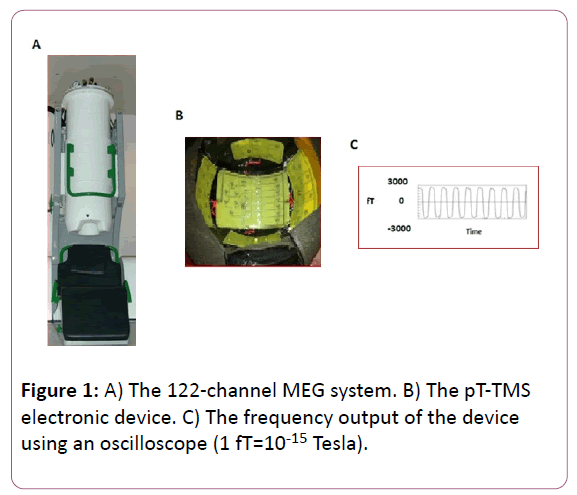MEG and Pico Tesla-TMS in Greece
Athanasia Kotini*
Laboratory of Medical Physics, Medical School, Democritus University of Thrace, Alexandroupoli, Greece
- *Corresponding Author:
- Athanasia Kotini
Associate Professor
Laboratory of Medical Physics
Medical School, Democritus University of Thrace
University Campus
Alexandroupoli 68100, Greece
Tel: +302551030519
E-mail: akotini@med.duth.gr, athanasia.kotini@gmail.com
Received Date: January 24, 2016; Accepted Date: January 27, 2017; Published Date: February 01, 2017
Citation: Kotini A, Anninos P. MEG and Pico Tesla-TMS in Greece. J Clin Med Ther. 2017, 2:1.
Copyright: © 2017 Kotini A, et al. This is an open-access article distributed under the terms of the Creative Commons Attribution License, which permits unrestricted use, distribution and reproduction in any medium, provided the original author and source are credited.
Editorial
Magnetoencephalography (MEG) is a non-invasive method that detects the magnetic fields produced by the neuronal activity of the brain. In our lab, biomagnetic measurements were performed using a whole-head 122-channel MEG gradiometer device (Neuromag-122, Neuromag Ltd., Helsinki, Finland) (Figure 1A). We used an electromagnetically shielding room for the MEG in order to avoid extraneous electromagnetic noise. The spontaneous MEG recordings were taken with a sampling frequency rate of 256 Hz and associated Nyquist frequency 128 Hz, which was well above the constituent frequency components of interest in our MEG recordings and avoid aliasing artifacts. The MEG signals were filtered with cut-off frequencies at 0.3 and 40 Hz. The research protocols were approved by the Research Committee of the Democritus University of Thrace. Funding for this work was provided by a collaboration of General Secretariat of Research and Technology, GR and ERGO AEBE, INC, GR under a research program (Grant Number: 80623).
Transcranial Magnetic Stimulation (TMS) is a non-invasive method, easy to perform, without direct contact with the underlying skin and has been used to investigate a variety of clinical conditions. Anninos and Tsagas [1] invented an electronic device that increased the (2-7 Hz) frequencies of the recorded MEG of each participant towards frequencies of less than or equal to its frequencies of the alpha frequency range (8-13 Hz) (Figure 1B). Their invention is a piece of equipment for smoothing the dysfunctions of the central nervous system in combination with the use of the MEG. The device consists of one generator of alternative low voltage that produces a frequency from 2-7 Hz, and supplies a number of selected coils of one group which consists of alike rows of coils, or a plurality of groups of similar coils arranged in rows. The pico Tesla (pT) (1pT=10-12 T)-TMS electronic device is a modified helmet containing up to 122 coils that cover the 7 brain regions: Frontal, vertex, occipital, right-left temporal, right-left parietal. It produces pT-TMS range modulations of magnetic flux in the alpha frequency range of each subject. The pT-TMS device was constructed for each participant to generate a square wave (so as to look like the firing activity of neurons in the brain) (Figure 1C) [2-9].
Anninos et al. [10] proposed a “Neural Net Model” that suggested that pT-TMS causes a temporally modulated neuronal reserve in areas showing irregular activity in the frequencies of 2-7 Hz. This suggestion is in accordance with information presented by other researchers.
References
- Anninos PA, Tsagas N (1995) Electronic apparatus for treating epileptic individuals US patent 5453072.
- Anninos PA, Tsagas N, Jacobson JI, Kotini A (1999) The biological effects of magnetic stimulation in epileptic patients. Panminerva Med 41: 207-215.
- Anninos P, Kotini A, Adamopoulos A, Tsagas N (2003) Magnetic stimulation can modulate seizures in epileptic patients. Brain Topogr 16: 57-64.
- Anninos P, Adamopoulos A, Kotini A, Tsagas N, Tamiolakis D, et al. (2007) MEG evaluation of Parkinson's diseased patients after external magnetic stimulation. Acta Neurol Belg 107: 5-10.
- Anninos P, Kotini A, Anninou N, Adamopoulos A, Papastergiou A, et al. (2008) Meg recordings of patients with CNS disorders before and after external magnetic stimulation. J Integr Neurosci 7: 17-27.
- Anninos P, Adamopoulos A, Kotini A (2015) MEG as a Medical Diagnostic Tool in the Greek Population. Acta Medica 58: 71-78
- Anninos P, Chatzimichael A, Adamopoulos A, Kotini A, Tsagas N (2016) A combined study of MEG and pico-Tesla TMS on children with autism disorder. J Integr Neurosci 23: 1-17.
- Anninos P, Adamopoulos A, Kotini A, Tsagas N (2016) MEG evaluation of pico-Tesla external TMS on multiple sclerosis patients. Mult Scler Relat Disord 8: 45-53.
- Anninos P, Adamopoulos A, Kotini A, Tsagas N (2016) Combined MEG and pT-TMS study in Parkinson's disease. J Integr Neurosci 15: 145-162.
- Anninos PA, Tsagas N, Adamopoulos A (1989) A brain model theory for epilepsy and the mechanism for treatment with experimental verification using SQUID measurements. In: Cotterill RM (ed.) Models of brain function. NY, USA: Cambridge University Press pp: 405-421.
Open Access Journals
- Aquaculture & Veterinary Science
- Chemistry & Chemical Sciences
- Clinical Sciences
- Engineering
- General Science
- Genetics & Molecular Biology
- Health Care & Nursing
- Immunology & Microbiology
- Materials Science
- Mathematics & Physics
- Medical Sciences
- Neurology & Psychiatry
- Oncology & Cancer Science
- Pharmaceutical Sciences

